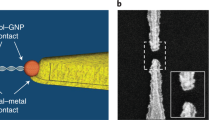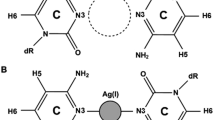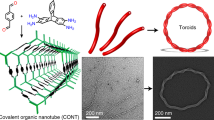Abstract
We describe a general method to integrate DNA strands between single-walled carbon nanotube electrodes and to measure their electrical properties. We modified DNA sequences with amines on either the 5′ terminus or both the 3′ and 5′ termini and coupled these to the single-walled carbon nanotube electrodes through amide linkages, enabling the electrical properties of complementary and mismatched strands to be measured. Well-matched duplex DNA in the gap between the electrodes exhibits a resistance on the order of 1 MΩ. A single GT or CA mismatch in a DNA 15-mer increases the resistance of the duplex ∼300-fold relative to a well-matched one. Certain DNA sequences oriented within this gap are substrates for Alu I, a blunt end restriction enzyme. This enzyme cuts the DNA and eliminates the conductive path, supporting the supposition that the DNA is in its native conformation when bridging the ends of the single-walled carbon nanotubes.
This is a preview of subscription content, access via your institution
Access options
Subscribe to this journal
Receive 12 print issues and online access
$259.00 per year
only $21.58 per issue
Buy this article
- Purchase on Springer Link
- Instant access to full article PDF
Prices may be subject to local taxes which are calculated during checkout




Similar content being viewed by others
References
Eley, D. D. & Spivey, D. I. Semiconductivity of organic substances: Nucleic acid in dry state. Trans. Faraday Soc. 58, 411–415 (1962).
O'Neill, M. A. & Barton, J. K. in Sequence-Dependent DNA Dynamics: The Regulator of DNA-Mediated Charge Transport in Charge Transfer in DNA (ed. Wagenknecht, H. A.) 27–75 (Springer-Verlag, Weinheim, Germany, 2005).
Schuster, G. B. (ed.) Long-range charge transfer in DNA I & II. Top. Curr. Chem. 236 (2004).
Giese, B. Long-distance electron transfer through DNA. Ann. Rev. Biochem. 71, 51–70 (2002).
Delaney, S. & Barton, J. K. Long-range DNA charge transport. J. Org. Chem. 68, 6475–6483 (2003).
Murphy, C. J. et al. Long-range photoinduced electron transfer through a DNA helix. Science 262, 1025–1029 (1993).
Lewis, F. D. et al. Distance-dependent electron transfer in DNA hairpins. Science 277, 673–676 (1997).
Hall, D. B., Holmlin, R. E. & Barton, J. K. Oxidative DNA damage through long-range electron transfer. Nature 382, 731–735 (1996).
Dandliker, P. J., Holmlin, R. E. & Barton, J. K. Oxidative thymine dimer repair in the DNA helix. Science 275, 1465–1468 (1997).
Kelley, S. O. & Barton, J. K. Electron transfer between bases in double helical DNA. Science 283, 375–381 (1999).
Gasper, S. M. & Schuster, G. B. Photoinduced electron transfer to anthraquinones linked to duplex DNA: the effect of gaps and traps on long-range radical cation migration. J. Am. Chem. Soc. 119, 12762–12771 (1997).
Giese, B., Amaudrut, J., Kohler, A. K., Spormann, M. & Wesselly, S. Direct observation of hole transfer through DNA by hopping between adenine bases and by tunnelling. Nature 412, 318–320 (2001).
Wan, C., Fiebig, T., Kelley, S. O., Treadway, C. R. & Barton, J. K. Femtosecond dynamics of DNA-mediated electron transfer. Proc. Natl Acad. Sci. USA 96, 6014–6019 (1999).
Nunez, M. E., Hall, D. B. & Barton, J. K. Long-range oxidative damage to DNA: Effects of distance and sequence. Chem. Biol. 6, 85–97 (1999).
Henderson, P. T., Jones, D., Hampikian, G., Kan, Y. & Schuster, G. B. Long-distance charge transport in duplex DNA: The phonon-assisted polaron-like hopping mechanism. Proc. Natl Acad. Sci. USA 96, 8353–8358 (1999).
Kelley, S. O., Homlin, R. E., Stemp, E. D. A. & Barton, J. K. Photoinduced electron transfer in ethidium-modified DNA duplexes: Dependence on distance and base stacking. J. Am. Chem. Soc. 119, 9861–9870 (1997).
Boal, A. K. et al. DNA-bound redox activity of DNA repair glycosylases containing [4Fe-4S] clusters. Biochemistry 44, 8397–8407 (2005).
Nunez, M. E., Holmquist, G. P. & Barton, J. K. Evidence for DNA charge transport in the nucleus. Biochemistry 40, 12465–12471 (2001).
Boon, E. M., Salas, J. E., & Barton, J. K. An electrical probe of DNA–protein interactions on DNA-modified surfaces. Nature Biotechnol. 20, 282–286 (2002).
Boon, E. M. et al. Mutation detection by electrocatalysis at DNA-modified electrodes. Nature Biotechnol. 18, 1096–1100 (2000).
Guo, X. et al. Covalently bridging gaps in single-walled carbon nanotubes with conducting molecules. Science 311, 356–359 (2006).
Guo, X. et al. Single-molecule devices as scaffolding for multicomponent nanostructure assembly. Nano Lett. 7, 1119–1122 (2007).
Guo, X. et al. Chemoresponsive monolayer transistors. Proc. Natl Acad. Sci USA 103, 11452–11456 (2006).
Whalley, A. C., Steigerwald, M. L., Guo, X. & Nuckolls, C. Reversible switching in molecular electronic devices. J. Am. Chem. Soc. 129, 12590–12591 (2007).
Fink, H. W. & Schonenberger, C. Electrical conduction through DNA molecules. Nature 398, 407–410 (1999).
Porath, D., Bezryadin, A., de Vries, S. & Dekker, C. Direct measurement of electrical transport through DNA molecules. Nature 403, 635–638 (2000).
Storm, A. J., van Noort, J., de Vries, S. & Dekker, C. S. Insulating behavior for DNA molecules between nanoelectrodes at the 100 nm length scale. Appl. Phys. Lett. 79, 3881–3883 (2001).
Kasumov, A. Y. et al. Proximity-induced superconductivity in DNA. Science 291, 280–282 (2000).
Gohen, H., Nogues, C., Naaman, R. & Porath, D. Direct measurement of electrical transport through single DNA molecules of complex sequence. Proc. Natl Acad. Sci. USA 102, 11589–11593 (2005).
van Zalinge, H. et al. Variable-temperature measurements of the single-molecule conductance of double-stranded DNA. Angew. Chem. Int. Edn 45, 5499–5502 (2006).
Hihath, J., Xu, B., Zhang, P. & Tao, N. Study of single-nucleotide polymorphisms by means of electrical conductance measurements. Proc. Natl Acad. Sci. USA 102, 16979–16983 (2005).
Wierzbinski, E., Arndt, J., Hammond, W. & Slowinski, K. In situ electrochemical distance tunneling spectroscopy of ds-DNA molecules. Langmuir 22, 2426–2429 (2006).
Ceres, D. M. & Barton, J. K. In situ scanning tunneling microscopy of DNA-modified gold surfaces: bias and mismatch dependence. J. Am. Chem. Soc. 125, 14964–14965 (2003).
Bhattacharya, P. K. & Barton, J. K. The influence of intervening mismatches on long-range guanine oxidation in DNA duplexes. J. Am. Chem. Soc. 123, 8649–8656 (2001).
O'Neill, M. A., Becker, H.-C., Wan, C., Barton, J. K. & Zewail, A. H. Ultrafast dynamics in DNA-mediated electron transfer: base gating and the role of temperature. Angew. Chem. Int. Edn 42, 5896–5900 (2003).
Tsang, D. Z. & Dresselhaus, M. S. The c-axis electrical conductivity of kish graphite. Carbon 14, 43–46 (1976).
Acknowledgements
We acknowledge primary financial support from the Nanoscale Science and Engineering Initiative of the National Science Foundation (NSF) under NSF award number (CHE-0117752 and CHE-0641523) and by the New York State Office of Science, Technology, and Academic Research (NYSTAR) and the NSF NIRT Award (ECCS-0707748). C.N. acknowledges a NSF CAREER award (no. DMR-02-37860). J.K.B. thanks the National Institutes of Health (NIH) (JKB-GM61077) for their financial support of this work.
Author information
Authors and Affiliations
Contributions
X.G. and A.G. performed the experiments and wrote the manuscript. J.H., J.K.B. and C.N. designed the research and wrote the manuscript.
Corresponding authors
Supplementary information
Supplementary Information
Supplementary figures S1–S7 (PDF 636 kb)
Rights and permissions
About this article
Cite this article
Guo, X., Gorodetsky, A., Hone, J. et al. Conductivity of a single DNA duplex bridging a carbon nanotube gap. Nature Nanotech 3, 163–167 (2008). https://doi.org/10.1038/nnano.2008.4
Received:
Accepted:
Published:
Issue Date:
DOI: https://doi.org/10.1038/nnano.2008.4
This article is cited by
-
Chemiresistive sensing with functionalized carbon nanotubes
Nature Reviews Methods Primers (2023)
-
From molecular to supramolecular electronics
Nature Reviews Materials (2021)
-
Backbone charge transport in double-stranded DNA
Nature Nanotechnology (2020)
-
Repurposing DNA-binding agents as H-bonded organic semiconductors
Nature Communications (2019)
-
Biological synthesis of high-conductive pili in aerobic bacterium Pseudomonas aeruginosa
Applied Microbiology and Biotechnology (2019)



